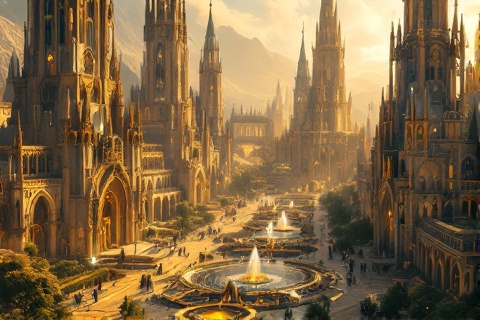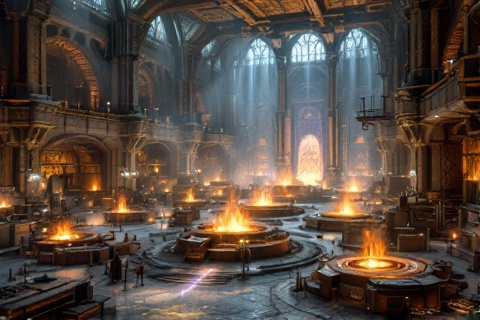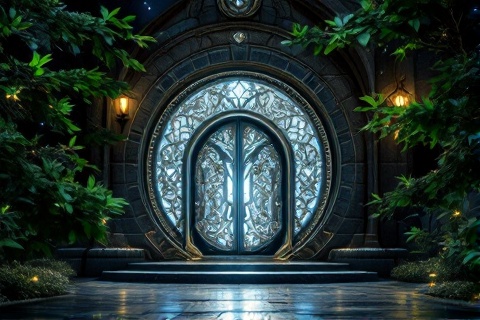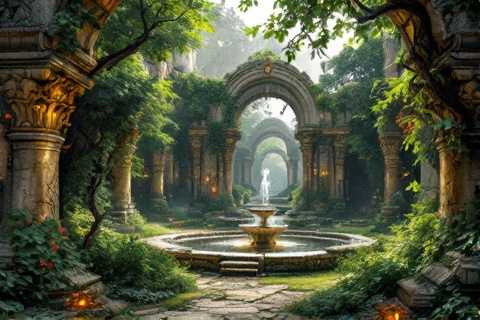
Eregion: The Hidden Jewel of Middle-earth
Unveiling the History and Legacy of the Elven Land of Celebrimbor
The Land of Holly

Eregion, a realm of profound significance in the Second Age
of Middle-earth, occupied the fertile lands west of the
Misty Mountains and south of the hidden valley of Imladris (Rivendell). In the
Common Speech of Men, this region became known as Hollin, deriving
its name from the vast groves of holly trees that flourished throughout its
bounds. The realm was established early in the Second Age by Noldorin
Elves who departed from Lindon under the
leadership of Celebrimbor, grandson of Fëanor, seeking to
establish their own domain where they could freely pursue their crafts.
The holly trees that gave Eregion its Common Speech name were not merely
decorative but held deep significance for its inhabitants. These evergreen
sentinels stood as living monuments throughout the realm, their dark leaves and
bright red berries providing color even in the depths of winter. Founded around
the year 750 of the Second Age, Eregion represented a new chapter for the
Noldorin Elves who sought to recreate something of the glory of their ancient
homeland of Valinor in Middle-earth.
The establishment of Eregion marked a significant moment in the history of the
Second Age, as these Noldorin Elves, led by the house of Fëanor's last
descendant, chose to settle in a location that would prove strategically vital.
Their migration from Lindon, where Gil-galad ruled as High King, represented
both a desire for independence and an ambitious vision to create a new center of
elvish craft and learning in Middle-earth.
The City of Ost-in-Edhil

Ost-in-Edhil, the capital city of Eregion, stood as the greatest center of elven
craftsmanship in Middle-earth during the Second Age. Under the leadership of
Celebrimbor, the city became home to the Gwaith-i-Mírdain, the Brotherhood of
Jewel-smiths, whose works would eventually surpass all but those of Fëanor
himself. The city's reputation drew skilled artisans from across Middle-earth,
making it a beacon of creativity and innovation.
The architectural magnificence of Ost-in-Edhil reflected the sophisticated
tastes of its Noldorin builders, who incorporated precious gems and intricate
metalwork into every aspect of its construction. The city's buildings featured
delicate spires adorned with precious stones that caught and reflected sunlight,
while elaborate metal lattices and frameworks demonstrated the inhabitants'
mastery over both stone and metal.
The strategic location of Ost-in-Edhil, mere leagues from the West-gate of
Khazad-dûm, was no coincidence but a carefully chosen site
that facilitated close cooperation with the Dwarves of Durin's
Folk. This proximity allowed for unprecedented collaboration
between the two races, leading to innovations in both crafting techniques and
architectural designs.
As a center of elvish learning and craftsmanship, Ost-in-Edhil housed extensive
libraries and workshops where knowledge was both preserved and advanced. The
city became a gathering place for loremasters and craftsmen who shared their
knowledge freely, creating an environment of collaborative learning that would
not be seen again in Middle-earth after its fall.
Architecture and Craftsmanship
The architectural style of Eregion represented a unique fusion of elvish grace
and dwarven durability. The Noldorin builders incorporated the finest aspects of
dwarven stonework techniques, learning from their allies in Khazad-dûm how to
work with stone in ways that preserved its natural strength while achieving
unprecedented delicacy in design. These techniques allowed for the creation of
structures that seemed to defy gravity while maintaining remarkable structural
integrity.
Throughout Eregion, particularly in Ost-in-Edhil, metalwork and jewel-craft were
not merely decorative elements but integral parts of the architecture. Buildings
featured frameworks of precious metals that served both practical and aesthetic
purposes, while gems were strategically placed to capture and reflect light in
specific ways. Even everyday structures such as homes and public buildings
incorporated these elements, creating an environment where art and functionality
merged seamlessly.
The workshop districts of Eregion's cities showcased the realm's dedication to
craftsmanship through their specialized forges and crafting halls. These
facilities were designed with specific purposes in mind, from the delicate work
of jewelry making to the more robust requirements of metalworking. The
Gwaith-i-Mírdain maintained numerous workshops, each equipped with tools and
facilities tailored to particular aspects of their craft.
The Great Forges

Within Ost-in-Edhil, the Gwaith-i-Mírdain constructed specialized facilities
dedicated to the creation of magical artifacts, most notably the Rings of
Power. These workshops contained unique forges capable
of reaching and maintaining the precise temperatures needed for working with
enchanted materials. The creation of these facilities represented the pinnacle
of Second Age elven engineering and magical knowledge.
The workshops housed an impressive array of specialized equipment designed
specifically for working with precious metals and gems of magical significance.
These tools, many of which were themselves imbued with power, allowed the elven
craftsmen to manipulate materials in ways that would have been impossible
through conventional means. The most sophisticated of these devices were used in
the creation of the Rings of Power, though their exact nature remains a matter
of scholarly speculation.
The advanced ventilation systems integrated into these workshops represented a
marvel of Second Age engineering. These systems not only provided the precise
air flow needed for various crafting processes but also helped maintain the
purity of the workspace, a crucial factor when working with magical materials.
The careful management of air flow also helped control temperatures and remove
potentially harmful fumes from the crafting areas.
The workshops' connection to underground springs and mineral sources provided
the craftsmen with direct access to the purest materials available in
Middle-earth. These natural resources were carefully channeled through an
elaborate system of filters and reservoirs, ensuring that only the cleanest
water and finest mineral specimens were used in the creation of magical items.
This infrastructure played a crucial role in the creation of the Rings of Power
and other legendary artifacts.
Natural Resources and Geography

The wealth of Eregion was founded upon the abundant natural resources found in
the nearby Misty Mountains. The region had access to rich deposits of precious
metals including gold, silver, and the rare metals needed for crafting magical
items. Additionally, the mountains yielded a variety of precious gems, from
diamonds to the more exotic stones favored by the Noldorin craftsmen for their
magical properties.
The elaborate network of springs and streams that traversed Eregion provided the
realm with an invaluable resource: pure water essential for various crafting
processes. These water sources, many of which originated high in the Misty
Mountains, were carefully managed and channeled through sophisticated irrigation
systems. The purity of this water was crucial for the creation of magical items
and the processing of precious materials.
The fertile valleys of Eregion supported extensive gardens and agricultural
areas that provided sustenance for its inhabitants. The elves of Eregion
maintained carefully tended gardens that produced not only food but also plants
used in various crafting processes. These gardens included herbs with magical
properties and plants whose essences were incorporated into various elven
crafts.
Relations with Khazad-dûm
The relationship between the Elves of Eregion and the Dwarves of Khazad-dûm
represented one of the most remarkable partnerships in the history of
Middle-earth. This friendship, unprecedented in its depth and productivity,
flourished during the Second Age when both realms were at the height of their
power. The mutual respect and understanding between Celebrimbor and Narvi the
Dwarf symbolized this unique alliance.
A sophisticated network of roads and trade routes connected Eregion with
Khazad-dûm through the Misty Mountains. These paths, constructed with both
elvish and dwarven expertise, facilitated regular commerce and cultural exchange
between the two realms. The roads were masterfully engineered to withstand the
harsh mountain weather while providing safe passage for travelers and goods.
The exchange of crafting techniques between the two peoples led to unprecedented
innovations in both cultures. The Noldorin Elves learned much about metallurgy
and stonework from the Dwarves, while sharing their own knowledge of enchantment
and fine metalwork. This collaborative environment fostered the development of
new techniques that neither race could have achieved alone.
The West-gate of Khazad-dûm served as the primary point of commerce between the
two realms, with a steady flow of goods and craftsmen passing through its doors.
Regular trade included precious metals and gems from the mines of Khazad-dûm,
while the Elves provided finished goods, textiles, and products of their magical
crafts. This commerce helped both realms prosper and contributed to their golden
age.
The West-gate of Khazad-dûm

The West-gate of Khazad-dûm stands as the greatest symbol of the friendship
between the Elves of Eregion and the Dwarves of Moria. Created through the
combined efforts of Narvi and Celebrimbor, this masterpiece of Second Age
craftsmanship represented the pinnacle of collaboration between the two peoples.
The gate's design incorporated the finest elements of both elvish and dwarven
architectural styles.
The doors were adorned with the emblems of both the House of Durin and the Elves
of Eregion, featuring intricate designs that told the story of the friendship
between the two peoples. The inscription on the doors, written in both Tengwar
and Dwarf-runes, welcomed travelers from both realms and stood as a testament to
the mutual respect between Elves and Dwarves.
The use of ithildin, a magical substance that only became visible in starlight
and moonlight, demonstrated the sophisticated magical craftsmanship of the
Second Age. This remarkable material, created by the Elves, was used to trace
delicate patterns and writings on the doors that would shine with a subtle
silvery glow under the light of the moon and stars. The gates thus combined
practical function with magical artistry in a way that exemplified the heights
of Second Age craftsmanship.
Legacy in Middle-earth

The architectural and artistic achievements of Eregion profoundly influenced
later elven settlements throughout Middle-earth. Elements of Eregion's
distinctive style, which combined practical functionality with aesthetic beauty,
can be seen in the design of realms such as Lothlórien and
the restored settlements of Imladris. The integration of natural elements with
constructed spaces became a hallmark of elven architecture.
Though Eregion fell in the Second Age, its crafting techniques and artistic
traditions were preserved by those who escaped its destruction. The survivors
carried their knowledge to other elven realms, where these methods were
maintained and developed further. The creation of items such as the Mirror of
Galadriel demonstrates how the magical crafting traditions of Eregion continued
to influence elven artifice throughout the Third Age.
The ruins of Eregion, still visible in the region known as Hollin during the
Third Age, served as a poignant reminder of the realm's former glory. These
remnants, though worn by time, continued to display the sophisticated
architectural techniques and artistic excellence that characterized the realm at
its height. The surviving structures, particularly the foundations of
Ost-in-Edhil, provided tangible evidence of the advanced civilization that once
flourished there.
